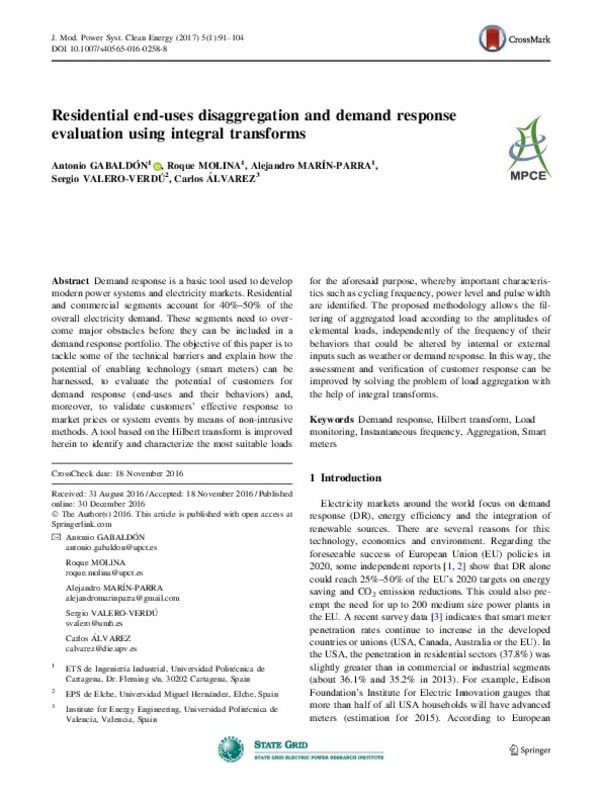Chardon A, Almén O, Lewis PE (2009) Demand response: a decisive breakthrough for Europe. Capgemini, Enerdata. https://www.capgemini.com/resources/demand_response_a_decisive_breakthrough_for_europe
Faruqui A, Harris D, Hledick R (2010) Unlocking the €53 billion savings from smart meters in the EU: how increasing the adoption of dynamic tariffs could make or break the EU’s smart grid investment. Energy Policy 38(10):6222–6231
Federal Energy Regulatory Commission (FERC) (2015) Assessment of demand response and advanced metering, staff report. http://www.ferc.gov/legal/staff-reports/2015/demand-response.pdf
[+]
Chardon A, Almén O, Lewis PE (2009) Demand response: a decisive breakthrough for Europe. Capgemini, Enerdata. https://www.capgemini.com/resources/demand_response_a_decisive_breakthrough_for_europe
Faruqui A, Harris D, Hledick R (2010) Unlocking the €53 billion savings from smart meters in the EU: how increasing the adoption of dynamic tariffs could make or break the EU’s smart grid investment. Energy Policy 38(10):6222–6231
Federal Energy Regulatory Commission (FERC) (2015) Assessment of demand response and advanced metering, staff report. http://www.ferc.gov/legal/staff-reports/2015/demand-response.pdf
FERC Order 745 (December 2011) & 719 (December 2009). http://www.ferc.gov/legal/maj-ord-reg.asp
European Commission (2011) Energy efficiency plan 2011, COM (2011) 109 final. http://eur-lex.europa.eu/LexUriServ
Joitn Research Center (JRC), European Commission (2010) Energy Service Companies market in Europe, status report 2010. http://publications.jrc.ec.europa.eu/repository/handle/111111111/15108
European Commission (2011) Impact assessment accompanying document “Energy Efficiency Plan 2011”, SEC (2011) 277 final. http://www.eurosfaire.prd.fr/7pc/bibliotheque/consulter.php?id=2357
European Environment Agency (EEA) (2012) Final energy consumption by sector and fuel. http://www.eea.europa.eu/data-and-maps/indicators/final-energy-consumption-by-sector-8/assessment-2
Piette MA, Watson D, Motegi N et al (2007) Automated critical peak pricing field tests: 2006 pilot program description and results. California Energy Commission, PIER Energy Systems Integration Research Program: CEC-500-03-026
Gomatom K, Holmes C, Kresta D (2013) Non-intrusive load monitoring. https://www.e3tnw.org
Dimetrosky S, Parkinson K, Lieb N (2013) Residential lighting evaluation protocol, Report NREl/SR-7A30-53827. National Renewable Energy Laboratory
Zeifman M, Roth K (2011) Nonintrusive appliance load monitoring: review and outlook. IEEE Trans Consum Electron 57(1):76–84
Liang J, Simon K, Kendall G et al (2010) Load signature study part I: basic concept, structure and methodology. IEEE Trans Power Deliv 25(2):551–560
Hart GW (1992) Nonintrusive appliance load monitoring. Proc IEEE 80(12):1870–1891
Powers J, Margossian B, Smith B (1991) Using a rule-based algorithm to disaggregate end-use load profiles from premise-level data. IEEE Comput Appl Power 4(2):42–47
Farinaccio L, Zmeureanu R (1999) Using a pattern recognition approach to disaggregate the total electricity consumption in a house into the major end-uses. Energy Build 30(3):245–259
Marceau ML, Zmeureanu R (2000) Nonintrusive load disaggregation computer program to estimate the energy consumption of major end uses in residential buildings. Energy Convers Manag 41(13):1389–1403
Baransju M, Voss J (2004) Genetic algorithm for pattern detection in NIALM systems. In: IEEE international conference on systems, man and cybernetics, 10–13 Oct, pp 3462–3468
Baranski H, Voss J (2004) Detecting patterns of appliances from total load data using a dynamic programming approach. In: Fourth IEEE international conference on data mining (ICDM’04), 1–4 Nov, Brighton, UK, pp 327–330
Sankara A (2015) Energy disaggregation in NIALM using hidden Markov models. Masters Theses, Missouri University of Science and Technology, Paper 7414
Kolter J, Jaakkola T (2012) Approximate inference in additive factorial HMMs with application to energy disaggregation. J Mach Learn 22:1472–1482
Leeb SB, Shaw SR, Kirtley SL (1995) Transient event detection in spectral envelope estimates for nonintrusive load monitoring. IEEE Trans Power Deliv 10(3):1200–1210
Patel SN, Robertson T, Kientz JA et al (2007) At the flick of a switch: detecting and classifying unique electrical events on the residential power line. In: Conference on ubiquitous computing, pp 271–288
Bonglifi R, Squartini S, Fagiani M et al (2015) Unsupervised algorithms for non-intrusive load monitoring: an up-to-date overview. In: EEEIC conference. doi: 10.1109/EEEIC.2015.7165334
Browne TJ, Vittal V, Heydt GT et al (2008) A comparative assessment of two techniques for modal identification from power system measurements. IEEE Trans Power Syst 23(3):1408–1415
Senroy N, Suryanarayanan S, Ribeiro PF (2007) An improved Hilbert–Huang method for analysis of time-varying waveforms in power quality. IEEE Trans Power Syst 22(4):1843–1850
Gabaldon A, Ortiz M, Molina R et al (2014) Disaggregation of electric loads of small customers through the application of the Hilbert transform. Energ Effic 7(4):711–728. doi: 10.1007/s12053-013-9250-6
Kolter JZ, Johnson MJ (2011) REDD: a public data set for energy disaggregation research. http://101.96.10.59/people.csail.mit.edu/mattjj/papers/kddsust2011.pdf
Fibaro wall switches. http://www.fibaro.com/en/the-fibaro-system/
IP-Symcon: innovative centre for the entire building automation. https://www.symcon.de/
Energy Information Administration (2001) End-use consumption electricity 2001. http://www.eia.gov/emeu/recs/recs2001/enduse2001/enduse2001.html
Poularikas AD (1999) The Hilbert transform, handbook of formulas and tables for signal processing. CRC Press LLC, Boca Raton
Huang NE, Shen Z, Long SR et al (1998) The empirical mode decomposition and the Hilbert spectrum for nonlinear and nonstationary time series analysis. Proced R Soc Lond 454(1971):903–995
Deering R, Kaiser JF (2005) The use of a masking signal to improve empirical mode decomposition. In: Proceedings IEEE international conference acoustic, speech, and signal processing, pp 485–488
Liang J, Simon K, Kendall G, Cheng J et al (2010) Load signature study part II: disaggregation framework, simulation, and applications. IEEE Trans Power Deliv 25(2):561–569
Load participation in ancillary services. http://www1.eere.energy.gov/analysis/pdfs
Gabaldón A, Guillamón A, Ruiz MC et al (2010) Development of a methodology for clustering electricity-price series to improve customer response initiatives. IET Gener Transm Distrib 4(6):706–715
[-]









